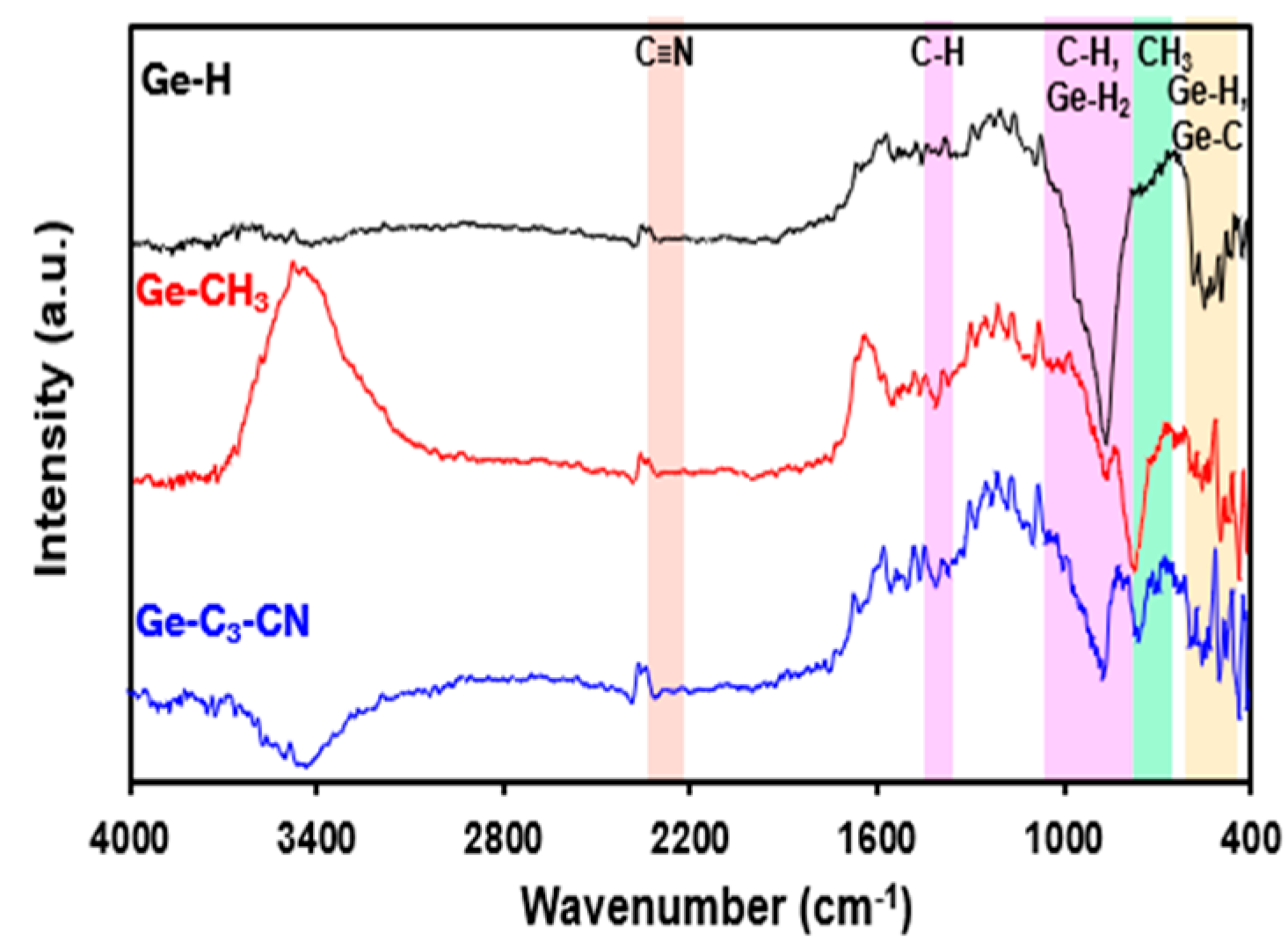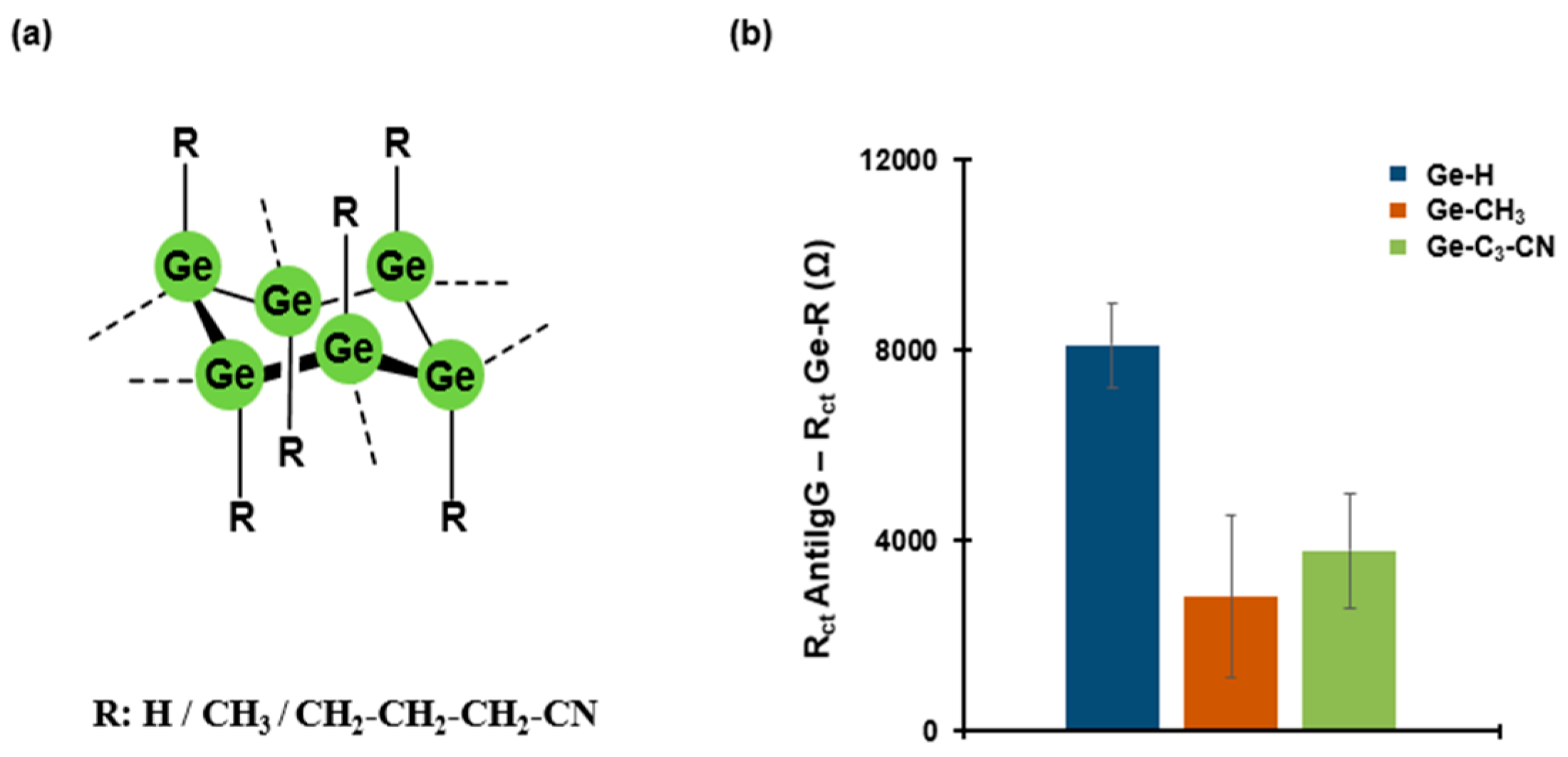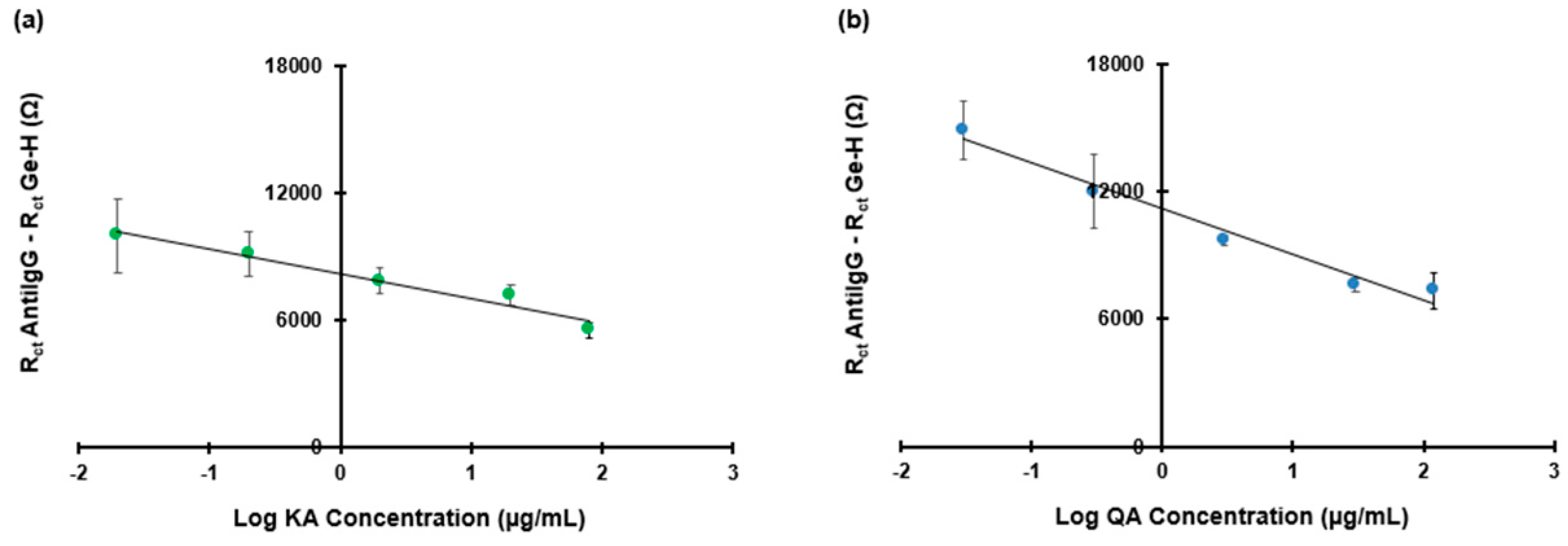Functionalized 2D Germanene and Its Derivatives for Electrochemical Detection of Gut-Derived Metabolites in Human Serum †
Abstract
:1. Introduction
2. Materials and Methods
3. Results and Discussion
3.1. Characterization of Germanene-Based Nanomaterials
3.1.1. FTIR
3.1.2. TEM
3.2. Performance of Germanene-Based Nanomaterials
3.3. Calibration Study
4. Conclusions
Author Contributions
Funding
Institutional Review Board Statement
Informed Consent Statement
Data Availability Statement
Conflicts of Interest
References
- Karle, A.; Twum, K.; Sabbagh, N.; Haddad, A.; Taimoory, S.M.; Szczesniak, M.M.; Trivedi, E.; Trant, J.F.; Beyeh, N.K. Naphthalene-functionalized resorcinarene as selective, fluorescent self-quenching sensor for kynurenic acid. Analyst 2022, 147, 2264–2271. [Google Scholar] [CrossRef] [PubMed]
- Zhang, B.D.; Liu, B.; Yin, Y.X.; Xu, L. Samarium-Based Turn-Off Fluorescence Sensor for Sensitive and Selective Detection of Quinolinic Acid in Human Urine and Serum. Inorg. Chem. 2023, 62, 1007–1017. [Google Scholar] [CrossRef] [PubMed]
- Neurological Disorders Affect Millions Globally: WHO Report. Available online: https://www.who.int/news/item/27-02-2007-neurological-disorders-affect-millions-globally-who-report (accessed on 21 April 2023).
- Fukushima, T.; Umino, M.; Sakamoto, T.; Onozato, M. A review of chromatographic methods for bioactive tryptophan metabolites, kynurenine, kynurenic acid, quinolinic acid, and others, in biological fluids. Biomed. Chromatogr. 2022, 36, e5308. [Google Scholar] [CrossRef] [PubMed]
- Sadok, I.; Gamian, A.; Staniszewska, M.M. Chromatographic analysis of tryptophan metabolites. J. Sep. Sci. 2017, 40, 3020–3045. [Google Scholar] [CrossRef] [PubMed]
- Singh, R.; Kashayap, S.; Singh, V.; Kayastha, A.M.; Mishra, H.; Saxena, P.S.; Srivastava, A.; Singh, R.K. QPRTase modified N-doped carbon quantum dots: A fluorescent bioprobe for selective detection of neurotoxin quinolinic acid in human serum. Biosens. Bioelectron. 2018, 101, 103–109. [Google Scholar] [CrossRef] [PubMed]
- Oh, J.S.; Seo, H.S.; Kim, K.H.; Pyo, H.; Chung, B.C.; Lee, J. Urinary profiling of tryptophan and its related metabolites in patients with metabolic syndrome by liquid chromatography-electrospray ionization/mass spectrometry. Anal. Bioanal. Chem. 2017, 409, 5501–5512. [Google Scholar] [CrossRef] [PubMed]
- Liu, N.; Bo, G.; Liu, Y.; Xu, X.; Du, Y.; Dou, S.X. Recent Progress on Germanene and Functionalized Germanene: Preparation, Characterizations, Applications, and Challenges. Small 2019, 15, e1805147. [Google Scholar] [CrossRef] [PubMed]
- Song, Z.; Ang, W.L.; Sturala, J.; Mazanek, V.; Marvan, P.; Sofer, Z.; Ambrosi, A.; Ding, C.; Luo, X.; Bonanni, A. Functionalized Germanene-Based Nanomaterials for the Detection of Single Nucleotide Polymorphism. ACS Appl. Nano Mater. 2021, 4, 5164–5175. [Google Scholar] [CrossRef]
- Ang, W.L.; Sturala, J.; Antonatos, N.; Sofer, Z.; Bonanni, A. Effect of surface chemistry on bio-conjugation and bio-recognition abilities of 2D germanene materials. Nanoscale 2021, 13, 1893–1903. [Google Scholar] [CrossRef] [PubMed]
- Rosli, N.F.; Rohaizad, N.; Sturala, J.; Fisher, A.C.; Webster, R.D.; Pumera, M. Siloxene, Germanane, and Methylgermanane: Functionalized 2D Materials of Group 14 for Electrochemical Applications. Adv. Funct. Mater. 2020, 30, 1910186. [Google Scholar] [CrossRef]
- Cheng, Z.X.; Ang, W.L.; Bonanni, A. Electroactive Nanocarbon Can Simultaneously Work as Platform and Signal Generator for Label-Free Immunosensing. ChemElectroChem 2019, 6, 3615–3620. [Google Scholar] [CrossRef]
- Kovalska, E.; Antonatos, N.; Luxa, J.; Sofer, Z. Edge-Hydrogenated Germanene by Electrochemical Decalcification-Exfoliation of CaGe(2): Germanene-Enabled Vapor Sensor. ACS Nano 2021, 15, 16709–16718. [Google Scholar] [CrossRef] [PubMed]
- Hartman, T.; Sturala, J.; Luxa, J.; Sofer, Z. Chemistry of Germanene: Surface Modification of Germanane Using Alkyl Halides. ACS Nano 2020, 14, 7319–7327. [Google Scholar] [CrossRef] [PubMed]
- Jiang, S.; Krymowski, K.; Asel, T.; Arguilla, M.Q.; Cultrara, N.D.; Yanchenko, E.; Yang, X.; Brillson, L.J.; Windl, W.; Goldberger, J.E. Tailoring the Electronic Structure of Covalently Functionalized Germanane via the Interplay of Ligand Strain and Electronegativity. Chem. Mater. 2016, 28, 8071–8077. [Google Scholar] [CrossRef]




Disclaimer/Publisher’s Note: The statements, opinions and data contained in all publications are solely those of the individual author(s) and contributor(s) and not of MDPI and/or the editor(s). MDPI and/or the editor(s) disclaim responsibility for any injury to people or property resulting from any ideas, methods, instructions or products referred to in the content. |
© 2023 by the authors. Licensee MDPI, Basel, Switzerland. This article is an open access article distributed under the terms and conditions of the Creative Commons Attribution (CC BY) license (https://creativecommons.org/licenses/by/4.0/).
Share and Cite
Lim, R.R.X.; Sofer, Z.; Bonanni, A. Functionalized 2D Germanene and Its Derivatives for Electrochemical Detection of Gut-Derived Metabolites in Human Serum. Eng. Proc. 2023, 48, 45. https://doi.org/10.3390/CSAC2023-14903
Lim RRX, Sofer Z, Bonanni A. Functionalized 2D Germanene and Its Derivatives for Electrochemical Detection of Gut-Derived Metabolites in Human Serum. Engineering Proceedings. 2023; 48(1):45. https://doi.org/10.3390/CSAC2023-14903
Chicago/Turabian StyleLim, Rachel Rui Xia, Zdeněk Sofer, and Alessandra Bonanni. 2023. "Functionalized 2D Germanene and Its Derivatives for Electrochemical Detection of Gut-Derived Metabolites in Human Serum" Engineering Proceedings 48, no. 1: 45. https://doi.org/10.3390/CSAC2023-14903
APA StyleLim, R. R. X., Sofer, Z., & Bonanni, A. (2023). Functionalized 2D Germanene and Its Derivatives for Electrochemical Detection of Gut-Derived Metabolites in Human Serum. Engineering Proceedings, 48(1), 45. https://doi.org/10.3390/CSAC2023-14903





